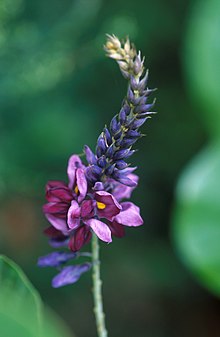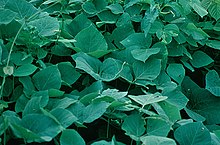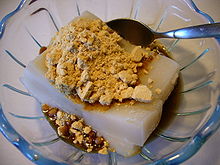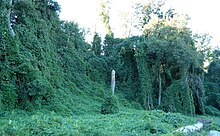Kudzu: Difference between revisions
more complete citation; no need for a redlink at least for now per WP:ONEEVENT; add another sentence about effectiveness of the technique |
|||
| Line 75: | Line 75: | ||
===United States=== |
===United States=== |
||
{{Main|Kudzu in the United States}} |
{{Main|Kudzu in the United States}} |
||
Kudzu was introduced from Japan into the [[United States]] at the Japanese pavilion in the 1876 Centennial Exposition in Philadelphia.<ref>[[Smithsonian Magazine]][http://www.smithsonianmag.com/science-nature/kudzu-abstract.html Kudzu: Love It or Run]</ref> It is now common along roadsides and other |
Kudzu was introduced from Japan into the [[United States]] at the Japanese pavilion in the 1876 Centennial Exposition in Philadelphia.<ref>[[Smithsonian Magazine]][http://www.smithsonianmag.com/science-nature/kudzu-abstract.html Kudzu: Love It or Run]</ref> It is now common along roadsides and other undisturbed areas throughout most of the southeastern United States. Kudzu has been spreading at the rate of 150,000 acres (61,000 ha) annually. |
||
===Other countries=== |
===Other countries=== |
||
Revision as of 06:13, 1 August 2011
| Kudzu | |
|---|---|

| |
| Scientific classification | |
| Kingdom: | |
| (unranked): | |
| (unranked): | |
| (unranked): | |
| Order: | |
| Family: | |
| Genus: | |
| Species: | P. lobata
|
| Binomial name | |
| Pueraria lobata | |
Kudzu (/[invalid input: 'icon']ˈkʊdzuː/; Pueraria lobata, and possibly other species in the genus Pueraria; see taxonomy section below) is a plant in the genus Pueraria in the pea family Fabaceae, subfamily Faboideae. It is a climbing, coiling, and trailing vine native to southern Japan and southeast China. Its name comes from the Japanese name for the plant, Kuzu (クズ or 葛).
Kudzu is sometimes called gé gēn[1] (Chinese: 葛根), and has earned such nicknames as the "foot-a-night vine", "mile-a-minute vine",[1] and "the vine that ate the South" (of the United States)[2] due to its out-of-control growth in the Southeastern United States. In Vietnam, it is called sắn dây.[3]
Taxonomy and nomenclature

Five species in the genus Pueraria are closely related and the name kudzu describes one or more of them. They are P. montana, P. lobata, P. edulis, P. phaseoloides and P. thomsoni.[4] The morphological differences between the five species are subtle, they can breed with each other, and it appears that introduced kudzu populations in the United States have ancestry from more than one of the species.[4][5] The name Pueraria thunbergiana is a synonym for Pueraria montana var. lobata.[6][7] [clarification needed] P. tuberosa, a species from the Indian subcontinent, is also known as kudzu.
Propagation
Kudzu spreads by vegetative expansion, via stolons (runners) that root at the nodes to form new plants and by rhizomes. Kudzu will also spread by seeds, which are contained in pods and mature in the autumn, although this is rare.[citation needed] One or two viable seeds are produced per cluster of pods. The hard-coated seeds may not germinate for several years, which can result in the reappearance of the species years after it was thought eradicated at a site.[citation needed]
Uses
Soil improvement and preservation
Kudzu has been used as a form of erosion control and also to enhance the soil. As a legume, it increases the nitrogen in the soil via a symbiotic relationship with nitrogen-fixing bacteria.[8] Its deep taproots also transfer valuable minerals from the subsoil to the topsoil, thereby improving the topsoil. In the deforested section of the central Amazon Basin in Brazil, it has been used for improving the soil pore-space in clay latosols, and thus freeing even more water for plants than in the soil prior to deforestation.[9]
Animal feed
Kudzu can be used by grazing animals as it is high in quality as a forage and palatable to livestock. It can be grazed until frost and even slightly after. Kudzu had been used in the southern United States specifically to feed goats on land that had limited resources. Kudzu hay typically has a 15–18% crude protein content and over 60% total digestible nutrient value. The quality of it decreases, however, as vine content increases relative to the leaf content. Kudzu also has low forage yields despite its great deal of growth, yielding around two to four tons of dry matter per acre annually. It is also difficult to bale due to its vining growth and its slowness in shedding water. This makes it necessary to place kudzu hay under sheltered protection after being baled. Kudzu is readily consumed by all types of grazing animals, yet frequent grazing over 3 to 4 years can ruin stands. Thus kudzu only serves well as a grazing crop on a temporary basis.[10]
Medicine

The Harvard Medical School is studying kudzu as a possible way to treat alcoholic cravings, by turning an extracted compound from the herb into a medical drug.[11] The mechanism for this is not yet established, but it may have to do with both alcohol metabolism and the reward circuits in the brain.
Kudzu also contains a number of useful isoflavones, including daidzein (an anti-inflammatory and antimicrobial agent). Daidzin is a cancer preventive and is structurally related to genistein (an antileukemic agent). Kudzu is a unique source of the isoflavone puerarin. Kudzu root compounds can affect neurotransmitters (including serotonin, GABA, and glutamate.) It has shown value in treating migraine and cluster headaches.[12] It is recommended for allergies and diarrhea.[13]
Research in mice models suggests that kudzu is beneficial in women for control of some postmenopausal symptoms, such as hypertension and diabetes type II.[14]
In traditional Chinese medicine(TCM), where it is known as gé gēn (Chinese: 葛根), kudzu is considered one of the 50 fundamental herbs. It is used to treat tinnitus, vertigo, and Wei syndrome (superficial heat close to the surface).[citation needed]
Kudzu has traditionally been used as a remedy for alcoholism and hangover in China.[15] The root was used to prevent excessive consumption, while the flower was supposed to detoxify the liver and alleviate the symptoms afterwards.[16] Some TCM hangover remedies are marketed with kudzu as one of their active ingredients (e.g. Hangover Busters.) This has also been a common use in areas of the Southeastern United States.
It has also shown promise for treating Alzheimers' disease.[17]
It may help diabetes and cardiovascular disease.[18]
Starch

The roots contain starch, which has traditionally been used as a food ingredient in East Asia.
In Japan, the plant is known as kuzu and the starch named kuzuko. Kuzuko is used as in dishes including kuzumochi, mizu manjū, and kuzuyu.
In Vietnam, the starch called bột sắn dây is flavoured with pomelo oil and then used as a drink in the summer.
Other uses
In the Southern United States, kudzu is used to make soaps, lotions, jelly, and compost.[19] In Japan, kudzu powder is used to make a sort of herbal tea called kuzuyu. It has even been suggested that kudzu may become a valuable asset for the production of cellulosic ethanol.[20]
The fiber is used traditionally[21] and has also been investigated for potential uses such as clothing, wallpaper, and paper.[22][23]
It has been used for centuries in East Asia to make tea, health tonics, and fibers for kimonos. [24]
Invasive species

Canada
Kudzu was discovered July 2009 in a patch 110 metres wide and 30 metres deep, on a south-facing slope on the shore of Lake Erie near Leamington, Ontario, about 50 kilometres southeast of Windsor.[25]
Ecologist Gerald Waldron made the Leamington find while walking along the beach. He spotted the kudzu instantly, having read about its destructive expansion in the southeastern United States.[citation needed]
United States
Kudzu was introduced from Japan into the United States at the Japanese pavilion in the 1876 Centennial Exposition in Philadelphia.[26] It is now common along roadsides and other undisturbed areas throughout most of the southeastern United States. Kudzu has been spreading at the rate of 150,000 acres (61,000 ha) annually.
Other countries
During World War II, kudzu was introduced to Vanuatu and Fiji by United States Armed Forces to serve as camouflage for equipment.[citation needed] It is now a major weed.
Kudzu is also becoming a problem in northeastern Australia, and has been seen in isolated spots in Northern Italy (Lake Maggiore).
Control
Crown removal
For successful long-term control of kudzu, it is not necessary to destroy the entire root system, which can be quite large and deep. It is only necessary to use some method to kill or remove the kudzu root crown[27] and all rooting runners. The root crown is a fibrous knob of tissue that sits on top of the root (rhizome). Crowns form from vine nodes that root to the ground, and range from pea-size to basketball-size.[27] The older the crown, the deeper they tend to be found in the ground, because they are covered by sediment and plant debris over time. Nodes and crowns are the source of all kudzu vines, and roots cannot produce vines. If any portion of a root crown remains after attempted removal, the kudzu plant may grow back.
Mechanical methods of control involve cutting off crowns from roots, usually just below ground level. This immediately kills the plant. Cutting off vines is not sufficient for an immediate kill. It is necessary to destroy all removed crown material. Buried crowns can regenerate into healthy kudzu. Transporting crowns in soil removed from a kudzu infestation is one common way that kudzu "miraculously" spreads and shows up in unexpected locations.
Mowing
Close mowing every week, regular heavy grazing for many successive years, or repeated cultivation may be effective, as this serves to deplete root reserves.[27] If done in the spring, cutting off vines must be repeated as regrowth appears to exhaust the plant's stored carbohydrate reserves. Cut kudzu can be fed to livestock, burned, or composted; strides have been made in using it for vehicle fuel as ethanol.[citation needed]
Grazing
The city of Chattanooga, Tennessee has undertaken a trial program using goats and llamas that graze on the plant. As of 2007[update] the goats are grazing along the Missionary Ridge area in the east of the city.[28] Similar efforts to reduce widespread nuisance kudzu growth have also been undertaken in the city of Winston-Salem, North Carolina.[29]
Fire
Prescribed burning is also used on old extensive infestations to remove vegetative cover and promote seed germination for removal or treatment. It is usually done to prepare for treatment of the root crowns.[30] Landscape equipment, such as a skid loader ("Bobcat"), can also remove biomass. While fire is not an effective way to kill kudzu,[27] equipment, such as skid loaders, can remove crowns and thereby kill kudzu with minimal disturbance of soil.[27]
Herbicide
To properly manage kudzu, stem cutting should be immediately followed with the application of a systemic herbicide; for example, glyphosate,[31] Triclopyr,[31] or Tordon,[32] directly on the cut stem.[33] This process is an effective means of transporting the herbicide into the kudzu's extensive root system. The usage of herbicides can be combined with other methods of eradication and control, such as mowing, grazing, or burning, which can allow for an easier application of the chemical to the weakened plants.[34] When it comes to large-scale forestry infestations, soil-active herbicides have been shown to be highly effective.[33]
After initial herbicidal treatment, follow-up treatments and monitoring are usually necessary, depending on how long the kudzu has been growing in the area. It may require up to ten years of supervision, after the initial chemical placement, to make sure the plant does not return in the future.[35]
Herbicides which have been proven to be effective to control kudzu are claimed to be "rather safe to humans, but generally lethal on most plants."[36]
Fungi
Since 1998, the United States Department of Agriculture, Agricultural Research Service (ARS) has experimented with using the fungus Myrothecium verrucaria as a biologically-based herbicide against kudzu.[2] A diacetylverrucarol spray based on M. verrucaria works under a variety of conditions (including the absence of dew), causes minimal injury to many of the other woody plants in kudzu-infested habitats, and takes effect fast enough that kudzu treated with it in the morning starts showing evidence of damage by mid-afternoon.[2] Initial formulations of the herbicide produced toxic levels of trichothecene as a by-product, though the ARS discovered that growing M. verrucaria in a fermenter on a liquid instead of a solid diet limited or eliminated the problem.[2]
Helium
In 2010, sixteen-year-old Jacob Schindler designed a device that allows him to drill into the ground and dispenses helium which kills the kudzu while reportedly leaving other plants unharmed.[37] Effectiveness varies and further research is needed to identify the effect of factors such as the season, the soil, and the age of the kudzu.[38]
See also
References
- Notes
- ^ a b Kudzu from zooscape.com (an online retailer)
- ^ a b c d "Controlling Kudzu With Naturally Occurring Fungus". ScienceDaily. July 20, 2009. Retrieved 2009-07-20.
- ^ Kudzu in Vietnamese (Translator)
- ^ a b D. K. Jewett, C. J. Jiang, K. O. Britton, J. H. Sun and J. Tang (1 September 2003). "Characterizing Specimens of Kudzu and Related Taxa with RAPD's". Castanea. 68 (3): 254–260. ISSN 0008-7475.
{{cite journal}}: Unknown parameter|doi_brokendate=ignored (|doi-broken-date=suggested) (help)CS1 maint: multiple names: authors list (link) - ^ Sun, J H; Li, Z-C; Jewett, D K; Britton, K O; Ye, W H; Ge, X-J (2005). "Genetic diversity of Pueraria lobata (kudzu) and closely related taxa as revealed by inter-simple sequence repeat analysis". Weed Research. 45: 255. doi:10.1111/j.1365-3180.2005.00462.x.
- ^ "Pueraria thunbergiana (Sieb. & Zucc.) Benth". Integrated Taxonomic Information System. Retrieved November 3, 2009.
- ^ Pueraria thunbergiana (Siebold & Zucc.) Benth., GRIN Taxonomy for Plants, accessed November 3, 2009
- ^ Amanda Allen (2000). "Kudzu in Appalachia". ASPI Technical Series TP 55. Appalachia -- Science in the Public Interest. Retrieved August 20, 2007.
- ^ Chauvel, A; Grimaldi, M; Tessier, D (1991). "Changes in soil pore-space distribution following deforestation and revegetation: An example from the Central Amazon Basin, Brazil". Forest Ecology and Management. ProQuest. Retrieved August 20, 2007.
{{cite web}}: CS1 maint: multiple names: authors list (link) - ^ John Everest, James Miller, Donald Ball, Mike Patterson (1999). "Kudzu in Alabama: History, Uses, and Control". Alabama Cooperative Extension System. Retrieved August 20, 2007.
{{cite web}}: CS1 maint: multiple names: authors list (link) - ^ "Got a drinking problem? Try kudzu". MSNBC. Associated Press. 2006. Retrieved August 20, 2007.
- ^ "Kudzu". Med-owl.com. 2006. Archived from the original on July 8, 2007. Retrieved August 20, 2007.
- ^ Duke J. The Green Pharmacy, The Ultimate Compendium of Natural Remedies from the World's Foremost Authority on Healing and Herbs, 1997. Pp. 57; 281-282; 310.
- ^ "Grapes, Soy And Kudzu Blunt Some Menopausal Side Effects", Science Daily, 7 August 2007
- ^ Kudzu root, a starchy white root native to Japan and China, has been used for in traditional Chinese medicine to reduce alcohol intake and hangovers.
- ^ The flowers of Pueraria thunbergiana exhibit protective effects against ethanol-induced apoptosis in human neuroblastoma cells
- ^ Li J, Wang G, Liu J; et al. (2010). "Puerarin attenuates amyloid-beta-induced cognitive impairment through suppression of apoptosis in rat hippocampus in vivo". Eur. J. Pharmacol. 649 (1–3): 195–201. doi:10.1016/j.ejphar.2010.09.045. PMID 20868658.
{{cite journal}}: Explicit use of et al. in:|author=(help); Unknown parameter|month=ignored (help)CS1 maint: multiple names: authors list (link) - ^ Ka H. Wong, George Q. Li, Kong M. Li, Valentina Razmovski-Naumovski, Kelvin Chan.,"Kudzu root: Traditional uses and potential medicinal benefits in diabetes and cardiovascular diseases." Journal of Ethnopharmacology Volume 134, Issue 3, 12 April 2011, Pages 584-607 http://www.sciencedirect.com/science?_ob=ArticleURL&_udi=B6T8D-524WF56-1&_user=10&_coverDate=04%2F12%2F2011&_rdoc=1&_fmt=high&_orig=gateway&_origin=gateway&_sort=d&_docanchor=&view=c&_acct=C000050221&_version=1&_urlVersion=0&_userid=10&md5=910c6b6d938af0225cd41a5d951185f5&searchtype=a
- ^ Jeffrey Collins (2003). "If You Can't Beat Kudzu, Join It". Off the Wall. Duke Energy Employee Advocate. Retrieved August 20, 2007.
- ^ Richard G. Lugar, R. James Woolsey. The New Petroleum. Foreign Affairs. 1999. Vol. 78, No 1. p. 88.
- ^ Larry W. Mitich (Jan. - Mar., 2000). "Kudzu (Pueraria lobata (Willd.) Ohwi)". Weed Technology. 14 (1): 231–235. doi:10.1614/0890-037X(2000)014[0231:KPLWO]2.0.CO;2.
{{cite journal}}: Check date values in:|date=(help) - ^ Robert D. Tanner, S. Shahid Hussain, Lindsey A. Hamilton and Frederick T. Wolf (October 1979). "Kudzu (Pueraria Lobata): Potential agricultural and industrial resource". Economic Botany. 33 (4): 400–412. doi:10.1007/BF02858336. ISSN 1874-9364.
{{cite journal}}: Unknown parameter|doi_brokendate=ignored (|doi-broken-date=suggested) (help)CS1 maint: multiple names: authors list (link) - ^ Sibel Uludag, Veara Loha, Ales Prokop and Robert D. Tanner (March, 1996). "The effect of fermentation (retting) time and harvest time on kudzu (Pueraria lobata) fiber strength". Applied Biochemistry and Biotechnology. 57–58 (1): 75–84. doi:10.1007/BF02941690. ISSN 1599-0291.
{{cite journal}}: Check|issn=value (help); Check date values in:|date=(help)CS1 maint: multiple names: authors list (link) - ^ Smithsonian MagazineKudzu: Love It or Run
- ^ "Kudzu: Invasion of the killer vines or a tempest in a teapot?". Chatham-Kent Daily Post. September 27, 2009. Retrieved 2010-04-20.
- ^ Smithsonian MagazineKudzu: Love It or Run
- ^ a b c d e "Kudzu Control Without Chemicals". kokudzu.com. 2007. Retrieved August 20, 2007.
- ^ Bramlett, Betsy (2007-04-03). "Kudzu Goats And Friends Getting To Work On Missionary Ridge". The Chattanoogan. Retrieved 2007-08-20.
- ^ Bramlett, Betsy (2010-08-031). "Winston-Salem Using Goats To Attack Problem Kudzu Vines". WXII12.com. Retrieved 2010-09-08.
{{cite web}}: Check date values in:|date=(help) - ^ "Written Findings of the State Noxious Weed Control Board". Washington State Noxious Weed Control Board. 2007. Retrieved August 20, 2007.
- ^ a b Southeast Exotic Pest Plant Council Invasive Plant Manual
- ^ Missouri Department of Conservation - Kudzu
- ^ a b National Park Service - Kudzu
- ^ Bugwood Network (Center for Invasive Species and Ecosystem Health)
- ^ CWC (A vegetation chemical distribution company) on Kudzu
- ^ Auburn University publication on Kudzu in Alabama
- ^ Dean Poling (May 24, 2010). "Teen scientist, inventor kills kudzu". Valdosta Daily Times.
- ^ Bill Warhop (January 2011). "The Kudzu Kid". Atlanta Magazine.
- Sources
- This article was based in part on content from public domain web pages from the United States National Park Service and the United States Bureau of Land Management
External links
- Species Profile - Kudzu (Pueraria montana var. lobata), National Invasive Species Information Center, United States National Agricultural Library. Lists general information and resources for Kudzu.
